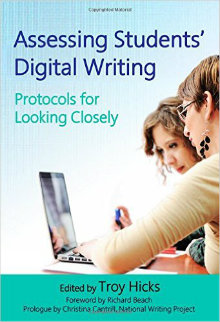How Do We Assess Students’ Digital Work?
Assessing Students’ Digital Writing: Protocols for Looking Closely
Troy Hicks, Editor
(Teachers College Press/NWP, 2015 – Learn more)

(Note of Disclosure: As a member of the National Writing Project and a partner in many NWP technology-related initiatives, I either know or have worked on projects with some of the contributing writers in this book.)
I don’t think there is any doubt that more and more educators are tapping into the potential of technology for boosting learning opportunities in classrooms, whether through one-to-one programs or BYOD (bring your own device) initiatives or just plain investment in computers.
This not to say, however, that every teacher everywhere is using technology, or that we are even using it in meaningful ways. But the trend is certainly shifting in the direction of more access.
An Assessment Quandary

We’re still cobbling, I would argue.
Luckily, resources like Assessing Students’ Digital Writing: Protocols for Looking Closely, edited by Troy Hicks, provide us with a clearer path to how we can examine the compositional moves of young writers working with various media in a way that makes sense to us, the teachers, and still provides meaningful feedback for our students.
This book’s first sentence, by Hicks, invites us in with the simple call to action: Look closely.
Hicks writes, “… it is crucial that teachers at all grade levels begin to initiate serious conversations about how writing is taught, how we value the process of writing, and how we play attention to the assessments of students’ multimodal compositions (p.2).”
A Collaborative Framework
And then Hicks lays out a protocol system that provides a valuable framework for examining student digital work.
While the book itself is built around a year-long endeavor of a group of educators sharing and examining student work together, many of the strategies made visible by this process could also be adapted by an individual teacher as a way to look closely at student work.
From Erin Klein’s second-graders using Augmented Reality tools to share knowledge of a research project with an authentic audience, to Bonnie Kaplan and Jack Zangerle showcasing the learning journey of a student composing a digital story on persuasion, to Christina Puntel highlighting a collaborative video game project on the theme of social justice, this book brings to the surface not just the success stories of learning, but also the difficulty we teachers have in “seeing” what is there in the digital learning in the first place.
The educators here examined student work via video conferencing hangouts, using as a lens the Multimodal Assessment Project tool, adapted by the National Writing Project. The MAP idea has several components, from the student-created artifacts themselves, to context of learning, to process and technique of composition, to habits of mind of students.
MAP Is a Map, of Sorts
The analysis protocol the teachers used here is adapted from the Collaborative Assessment Conference protocol, in which a teacher presents student work but remains silent as the others make observations along the lines of what do you see? and what is working in this composition? and what are you wondering about? Only then can the presenting teacher respond, by echoing what they heard from others and then providing context for the student work. The context comes last; the student composition comes first.
The result is a rich conversation by the sharing teacher and the outside observers, and the protocol system can unpack student compositional strategies and intent in unexpected ways, bringing new light to what the teacher first thought they saw in the work. By anchoring the discussions around MAP and then the discussion protocol, students and their work are always front and center, not the lesson plan or the content unit.
Meaningful Formative Assessment Tools
This, then, can lead to creating meaningful formative assessment tools that go beyond a “final grade” for digital composition when the assignment is given again in the future. The process can also force the teacher to re-examine their own instructional practice and assumptions.
As college professor Stephanie West-Puckett notes, in the aftermath of sharing a stop-motion video piece to the group, “… I have begun to see that the work of teaching multimodal composing is a two-way street. Students have vast stores of cultural composing knowledge, but they need our help to make that knowledge visible and open them for reflection and critique. (p. 118).”
An Invitation for Thinking Deeper
This is not the book for grabbing and photocopying quick assessment rubrics that would work with any piece of student media. It’s not that kind of volume.
Instead, Assessing Students’ Digital Writing: Protocols for Looking Closely is an invitation for thinking deeper about what our students are doing when they are creating multimedia work, and using that thinking to develop assessment strategies that are meaningful for your classroom. If you can find a cohort of teachers to utilize the MAP concept and the discussion protocol in your own Community of Practice or Professional Learning Communities or whatever buzzwords your school districts uses these days… even better.
The writers and editors of this collection have graciously shared student work and teaching resources at the National Writing Project’s Digital Is website.
____________
Kevin Hodgson is a sixth grade teacher in Southampton, Massachusetts, and is the technology co-director with the Western Massachusetts Writing Project. Kevin blogs regularly at Kevin’s Meandering Mind and tweets more often than is healthy under his @dogtrax handle. Kevin writes for MiddleWeb at his Working Draft blog.


































